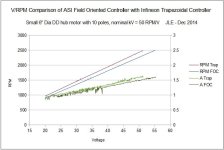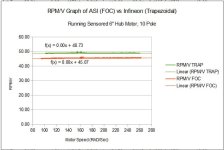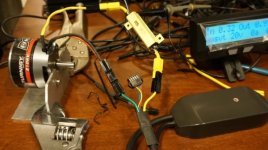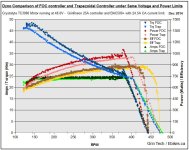izeman
1 GW
if it was at least double (or 3x) the power it would have been an instant buy.
Alan B said:Thanks Justin,
I was wondering about the top speed loss, not the efficiency difference. I switched from a trapezoidal to a sine wave controller (Xie Chang to Sabvoton) on my Cromotor bike and lost about 10% of the top speed (with no field weakening). Just curious if this is similar. The only bike I have that might work for this has a fairly low top speed, wondering how much I might lose by this.
Thanks!


riba2233 said:Thanks for the answer!Do you have the info on the max erpm?

madin88 said:thats the first really meaningful FOC vs. trapez comparison i have seen. Thanks!
justin, are you able to try max voltage (75V)?
what about installing a propeller on the motor to simulate some load?
im looking forward for the dyno tests - that will make it clear what benefits each type of controller has.
\/ampa said:Justin, do you dyno only for performance or also system efficency under same conditions ( watt in + same max.RPM)?
justin_le said:To do the same condition test that you describe would require running the FOC test at a 7.5% higher supply voltage with a 7.5% lower battery current limit. I'll try to squeeze that in too.
madin88 said:do you think it would be possible to compare the FOC controller in flux weakening mode so that RPM is similar to the trap controller? I think its not that easy, because if no load RPMs set similar they still can differ under load i guess.
maybe 93,5% throttle on the trap controller also is a good option instead of changing the battery voltage.
justin_le said:For these comparison tests It would be great if I could also measure the torque ripple too, and while the load cell measuring torque has a very fast dynamic response, the amplifier circuit I've got scaling it to a 0-5V range for the CA3 does quite a bit of low pass filtering so I'd need to rework that before being able to hook it up to the scope.
madin88 said:im looking forward for the dyno tests - that will make it clear what benefits each type of controller has.

\/ampa said:Thank you Justin.
That are results which are expectable for compairing slow and fast wind motors on same controller.
Could you also make a dyno test with both controllers have same max. RPM?
Alan B said:Fascinating!
I'm seeing slightly better efficiency on my commute with the FOC controller compared to the trap. The difference is not huge (in the neighborhood of 10%), but I wasn't expecting it. Looks like there is more to this story. Nice!
justin_le said:madin88 said:im looking forward for the dyno tests - that will make it clear what benefits each type of controller has.
OK. Well here is the first of them. For my test setup I was running the dyno bench with a Crysatlyte TC3080 hub motor and a lab power supply set at 48.0V for the supply source. The trapezoidal controller I was using is one of our 25A infineon based devices, the actual measured current at the current limit was 24.5A and then decreaseing to ~23.5-24A as the load increased. For the Field Oriented Controller, I had the BAC500+ set to run pretty much unlimited and then used a CA to effect a 24.5A current limit, so that it had the same max power input as the infineon. Of course it took a second for the current limit to kick in as I was sweeping down the RPM so that is why you see a little overshoot at about 370 rpm.
The graph comparison is very interesting and I'm glad you guys encouraged me to do this, because I hadn't actually given too much consideration on the actual change in behavior you'd experience when switching to a nominally spec'd FOC from a trapezoidal drive.
You can see that the max RPM is clearly on the order of 10% higher with the trapezoidal drive as expected.
The peak efficiency is pretty much the same 88-89% for both systems, although with the FOC controller it happens at the correspondingly lower RPM.
But then under loads at lower RPM's the efficiency of the FOC is about 3% better than the trapezoidal drive. As well, the output power and torque are higher for the FOC even with the same battery current draw. So say you are riding the bike at 300 RPM (~38 kph in a 26" wheel). Both the infineon and the BAC500+ controllers would be drawing 24.5A, but the BAC500 would be putting ~33Nm of torque on the wheel, compared to ~31 Nm for the infineon.
The effect is a little bit exaggerated in the graphs since the actual battery current draw on the infineon was more like 24.0A at this point, versus 24.5A on the BAC, but it's still quite evident that under loads all else being the same you get measurably better torque, power, and efficiency with the FOC.
I was not actually expecting this result to be honest, but there it is. In a nutshell:
Trapezoidal = higher top speed (7-10%), more power when operating at these higher speeds
Field Oriented Controller = Lower top speed, but definitely better torque (~5%) and efficiency (~3-4%) under load
liveforphysics said:Wow! Can you give us an overlay of just the efficiency difference, but scaled better to see how much better it is? If I'm seeing things correctly, it might be worth 4-5%!!!
okashira said:PLEASE try to run this test again at different throttle... 75%, 50%, 25% ... vary the amps or whatever your setup needs to simulate this .


\/ampa said:Could you also make a dyno test with both controllers have same max. RPM?
justin_le said:In general there is no measurable gain at all in efficiency with a FOC versus a regular trapezoidal controller, that is not a selling point at all. The motor efficiency may be a tad higher because of fewer harmonics, while the controller efficiency is definitely worse because of switching losses on all the channels.
justin_le said:\/ampa said:Could you also make a dyno test with both controllers have same max. RPM?
Here it is. I repeated the test with the FOC controller using a 51.4V power supply, rather than 48.0, so that the motor had the same unloaded RPM. In order to normalize the input power, I then set a 22.5A current limit with the CA, so that it matched approximately the 24A current limit of the 25A infineon controller.
So in this case, in every single metric the FOC does better. It has a stiffer rollback in RPM as you add torque close to the unloaded speed, it has higher peak power output, torque output, and better efficiency, at every single point on the graph. So if you account for the reduced V/RPM and choose your motor winding and battery voltage accordingly, it's a no brainer.
In light of this data, I now have to largely retract a statement I made to izeman earlier in this thread
justin_le said:In general there is no measurable gain at all in efficiency with a FOC versus a regular trapezoidal controller, that is not a selling point at all. The motor efficiency may be a tad higher because of fewer harmonics, while the controller efficiency is definitely worse because of switching losses on all the channels.
Scrap that, the gains in motor and drive efficiency are easily measurable and well overshadow the additional controller losses. Improved efficiency is indeed a selling point too
Since they run different voltage now. Its better to say another dyno test with 500W power draw from both.okashira said:Can you do one more at ~13 amps? I would LOVE to see how things look at a partial relative load.
\/ampa said:Since they run different voltage now. Its better to say another dyno test with 500W power draw from both.okashira said:Can you do one more at ~13 amps? I would LOVE to see how things look at a partial relative load.
